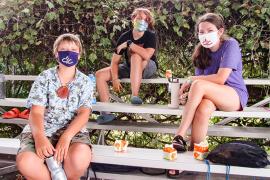We are all well aware of food allergies being a top concern for children, and especially those who are away from home at camp. Camps have worked hard to ensure that top food allergens are either nonexistent in their dining halls or that special allergy food lines are a top priority. But what about those nonfood allergies — which are certainly among the top five reasons for camper visits to the health center?
Nonfood allergies often fall into the category of environmental allergies. They encompass anything found within one’s living environment. In a camp setting, which is largely exposed to the great outdoors, environmental allergies to plants, pollens, dust, mold, and insects are commonplace and often result in symptoms such as:
- Congestion
- Cough
- Headache
- Itchy eyes
- Itchy skin
- Rash
- Sleep disruption
These nagging symptoms, if untreated, can represent significant barriers to campers and staff experiencing a fun and fruitful summer. Mitigating environmental allergies will only aid in a happier camp community.
Pesky Plants
Being away from home and city life or being in another state often means new flora and fauna. Exposure to different plants can mean new allergies. And campers who experience seasonal allergies at home may redevelop those allergy symptoms in the camp setting. So be sure to address children’s preexisting allergies and common camp allergens with incoming families. For those children with a known history of seasonal allergies, creating an allergy plan ahead of time is imperative. Whatever works for a child at home should be available to them at camp. Establishing a game plan for frequent health center visitors due to allergy symptoms is an important strategy to ensure allergy management success.
Combinations of antihistamines (Claritin, Zyrtec, Benadryl, etc.) with nasal-inhaled steroids (Flonase, Nasacort) are often key to taming and maintaining any allergy flare-ups at camp. In addition, simple things like nasal saline sprays can help to clean out nasal passages, clear congestion, and aid in the management of allergic rhinitis.
The camp setting is also perfect for allergic contact dermatitis. Skin irritations from poison ivy and poison oak are frequent.
The management of acute contact allergic dermatitis involves cleaning of the skin to remove any potential irritants and then likely using topical corticosteroids and sometimes Benadryl if the itching is diffuse and bothersome. Skin irritations can require a balance between covering and uncovering the affected area. In the case of poison ivy, for example, the vesicular lesions can spread rapidly with itching, so covering the rash area can help prevent further spread. The downside of covering lesions can be heat and humidity, leading to further irritation and infection.
Camp health-care staff should closely monitor cases of contact allergic dermatitis. In addition, camps should work hard to clear poison ivy, poison oak, and other itch-inducing plants from their grounds and alert campers and staff to areas of camp where these plants are often found.
Dreaded Dust and Mold
Don’t forget to consider dust and mold as potential allergy triggers. These allergens tend to lead to respiratory irritation, cough, and sometimes dermatitis — and not surprisingly, the camp setting is filled with dust and mold.
Camps should be proactive and take great care to provide cleaning and adequate ventilation in cabins and frequently assess for mold, especially in damp or humid environments.
Flyers and Creepy Crawlies
Finally, arthropods — such as bees, wasps, stinging ants, and mosquitoes (and sometimes furry caterpillars) — are always potential causes of allergic reactions at camp. Knowing which campers and staff may have significant and anaphylactic reactions to stings is critical, as is having EpiPens readily available. Severe allergic reactions will occasionally present themselves at camp, so all staff should be trained on how to spot potential signs of anaphylaxis.
It is important to note that arthropod stings and caterpillar irritations can be very painful or bothersome to many campers and staff even without a true allergy. Management of these symptoms with ice, cortisone creams, Benadryl, and sometimes baking soda-water paste can help to prevent further irritation, discomfort, and skin breakdown leading to infection.
A Well-Thought-Out Plan
One of the best parts of being at camp is the exposure to the outdoors. For many city-dwelling children, camp is one of the only times they are able to be among a bounty of trees, nature, fresh water, and fresh air. Being in nature has shown to be protective of health and wellness and is especially beneficial for mental health. So don’t let environmental allergies put a damper on a child’s summer — a suffering camper is never a happy one. Plan ahead. Make sure that environmental allergies are a crucial discussion with parents and staff before the start of camp, and address the physical environment to prevent the presence of as many allergens as possible. Your efforts will help to ensure a fun and healthy summer for all.
Jane Glazer, MSN, MA, CPNP, FNP-BC, has practiced in urgent care, college health, and residential camp health. She is interested in education, evidence-based best practices, and providing care to campers in a safe and fun way.




